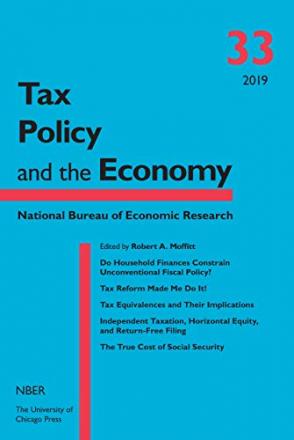Tax Policy and the Economy, Volume 33

This volume presents five new studies on taxation and government transfer programs. Scott Baker, Lorenz Kueng, Leslie McGranahan, and Brian Melzer explore whether “unconventional” fiscal policy in the form of pre-announced consumption tax changes can shift durables purchases intertemporally, and how such shifts are affected by consumer credit. Michelle Hanlon, Jeffrey Hoopes, and Joel Slemrod examine the effects of the Tax Cuts and Jobs Act on corporation behavior and on firms’ statements about their behavior. They focus on four outcomes: bonuses, investment, share repurchases, and dividends. Alan Auerbach discusses “tax equivalences”—disparate sets of policies that have the same economic effects—and also illustrates when these equivalences break down. Jeffrey Liebman and Daniel Ramsey use data from NBER’s TAXSIM model to investigate the equity implications of a switch from joint to independent taxation that could occur in conjunction with adoption of return-free tax filing. Alexander Blocker, Laurence Kotlikoff, Stephen Ross, and Sergio Villar Vallenas show how asset pricing can be used to value implicit fiscal debts, which are currently rarely measured or adjusted for risk, while accounting for risk properties. They apply their methodology to study Social Security.


